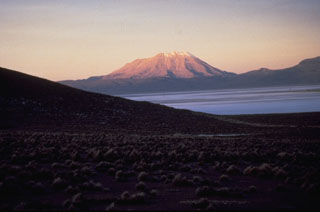Report on Ubinas (Peru) — 25 June-1 July 2014
Smithsonian Institution / US Geological Survey
Weekly Volcanic Activity Report, 25 June-1 July 2014
Managing Editor: Sally Sennert.
Please cite this report as:
Global Volcanism Program, 2014. Report on Ubinas (Peru) (Sennert, S, ed.). Weekly Volcanic Activity Report, 25 June-1 July 2014. Smithsonian Institution and US Geological Survey.
Ubinas
Peru
16.345°S, 70.8972°W; summit elev. 5608 m
All times are local (unless otherwise noted)
The Buenos Aires VAAC reported that during 25-28 June there was continuous steam and possible ash emission from Ubinas. In a press release from 30 June, IGP noted minimal releases of ash and gas emissions had been observed during the previous days. Gas-and-ash plumes observed on 30 June rose 1.8 km above the crater. Minor ashfall was reported SE.
Geological Summary. The truncated appearance of Ubinas, Perú's most active volcano, is a result of a 1.4-km-wide crater at the summit. It is the northernmost of three young volcanoes located along a regional structural lineament about 50 km behind the main volcanic front. The growth and destruction of Ubinas I was followed by construction of Ubinas II beginning in the mid-Pleistocene. The upper slopes of the andesitic-to-rhyolitic Ubinas II stratovolcano are composed primarily of andesitic and trachyandesitic lava flows and steepen to nearly 45°. The steep-walled, 150-m-deep summit crater contains an ash cone with a 500-m-wide funnel-shaped vent that is 200 m deep. Debris-avalanche deposits from the collapse of the SE flank about 3,700 years ago extend 10 km from the volcano. Widespread Plinian pumice-fall deposits include one from about 1,000 years ago. Holocene lava flows are visible on the flanks, but activity documented since the 16th century has consisted of intermittent minor-to-moderate explosive eruptions.
Sources: Instituto Geofísico del Perú (IGP), Buenos Aires Volcanic Ash Advisory Center (VAAC)

